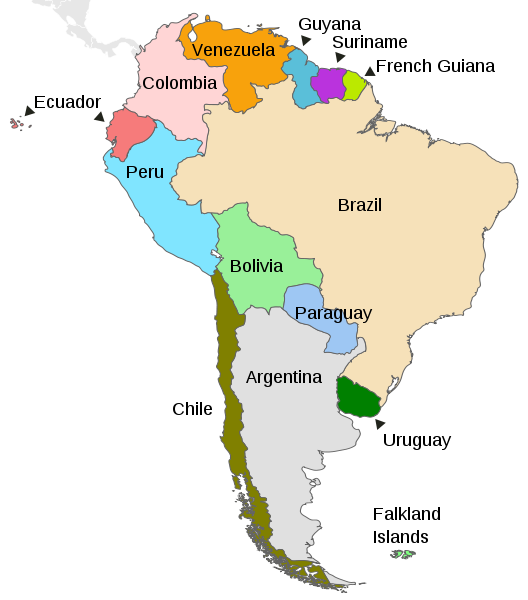Dasht-e Lut Desert in Iran (Image Source: Wikimedia Commons)
The World Meteorological Organization has approximately 11,119 weather stations on Earth. While this might seem like a lot, it equates to only 1 weather station for every ~56 million sq. miles (144.68 million sq. km) of Earth’s land surface. The hot deserts, such as the Sahara, the Gobi, the Sonoran, the Pilbara, the Lut, and the Taklamakan Desert - are so climatically harsh and remote that it’s impossible for routine measurements, let alone installation and regular maintenance. As a result, the majority of Earth’s true hot spots are not actually directly measured via ground-based instruments (i.e. thermometers).
Contrary to popular misconception, Death Valley’s Furnace Creek or the small town of El Azizia in Libya is NOT the hottest place on Earth. While both of these places are hot by normal living standards, they are not even serious contenders.
Fortunately for us, NASA has operated the Moderate Resolution Imaging Spectroradiometer (MODIS) which detects thermal radiance emitted by the land surface. These satellites view the entire Earth’s surface and provide temperatures to the most isolated hot spots on our Planet.
What is the hottest temperature recorded on Earth?
According to NASA, the hottest temperature on earth, 159.3°F (70.7°C) was recorded in the lowest area of the Lut Desert (Dasht-e-Lut), Iran, in 2005.
For comparison, Death Valley’s highest recorded temperature was 134°F / 56.7°C in 1913, which is 22% cooler
3 Hottest Temperatures recorded on Earth
Lut Desert, Iran: 159.3°F (70.7°C)
Australia’s Badlands: 157°F (69.3°C)
Turpan Basin, China: 152°F (66.8°C)
Lut Desert - Iran
The Lut Desert, Iran (Image Source: Alavipanah et al. 2007)
The deserts of Iran are often considered to be one of the hottest and driest desert regions on Earth. The Lut is one of Iran’s largest desert basins, consisting mainly of a largely dry and desolate plateau covered in salt flats.
In 2004, a Land Surface Temperature (LST) of 154°F (68°C) was recorded in the Lut Desert, only to be beaten in 2005 with an even higher temp of 159.3°F (70.7°C).
This remains to this day as the world’s hottest temperature ever recorded
Iran (Image Source: Wikimedia Commons)
The fact that the Lut Desert also recorded the highest temperature on earth for each year between 2004 to 2007, and in 2009, shows that this region is likely to be the hottest region on Earth. Although many of the world’s deserts are incredibly hot, the hottest temperatures tend to be recorded in low-lying deserts with a great deal of dry, rocky and dark-colored land – the Lut Desert fits this rather well, with dark pebbles, and closely-packed rock fragments being rather frequent features on the desert’s plateau.
Vegetation cover is also a large factor – although deserts generally contain low amounts of plant and shrub cover, desert areas range from slightly vegetated through to being completely barren. The hottest desert temperatures are recorded in areas with no vegetation and irrigation in the vicinity. This is certainly the case for the areas of the Lut Desert where the highest temperature readings were recorded, with no vegetation at all in these parts of the desert.
The Lut Desert
The Lut Desert, widely referred to as Dasht-e Lut (Persian: دشت لوت, "Emptiness Plain"), is a large salt desert located in the provinces of Kerman and Sistan and Baluchestan, Iran. It is the world's 27th-largest desert, and was inscribed on UNESCO's World Heritage List on July 17, 2016 (Image & Quote: Flickr).
Australia’s Badlands - Queensland
Image Source: (Wikimedia Commons)
In 2003, the hottest temperature recorded on Earth was 157°F (69.3°C), in a barren area of desert shrublands in Queensland, Australia, around 62 miles (100 km) to the north of the town of Winton.
Although it is around 1-1/2 degrees lower than the Lut Desert maximum, it is still a rather striking temperature reading, particularly as a small layer of dry grassland covers this part of Queensland’s desert.
Satellite images of the area show that the earth has a brown texture, helping the ground to absorb high amounts of solar radiation, heating the LST to large maxima. With an altitude of between 490 to 655 feet (150 to 200 m) above sea level, the region is also relatively low compared to other parts of the Australian outback, allowing for very high temperatures to be recorded here.
However, weather events likely explain the reason for the highest LST of 2003 being recorded here – there was a severe drought across much of north-eastern Australia in 2002 and 2003, including Queensland, contributing significantly to the dryness of the soil and lower vegetation levels, thus allowing the LST to reach an even higher level than it would normally.
Road Train
These 120-ton “road trains” that cruise along at 70+ mph (115 kph) are a frighting sight while traveling the dirty and dusty road of the Outback.
Turpan Basin: Flaming Mountain - China
Flaming Mountain, China (Image Source: Flickr)
Situated on the edge of the Taklamakan Desert, Flaming Mountain is the hottest place in China. Located in the Turpan Basin, its name given to a 100 km-long mountain range that is situated in the Xinjiang Uygur Autonomous Region of north-western China.
Map of China. The Taklamakan Desert is nearly twice the size of the U.S. state of Florida (Image Source: Flickr).
Since Flaming Mountain is an exposed area of dark orange-colored sandstone, with no ground vegetation. And during 2008, it was – the year’s highest global LST was recorded in the Turpan Basin, reaching a maximum of 152°F (66.8°C).
The region is ideal for high temperatures to accumulate here due to its large expanses of dark-colored red sandstone outcrops, which aid with the absorption of heat from the surrounding area.
However, it is also directly to the north-west of the Shanshan dune field, a vast system of dark-colored sand dunes which also increase the level of solar radiation absorbed into the ground in the Turpan Basin region, thereby increasing the ground surface temperature even further.
China’s Lowest Point
The basin also reaches rather low altitudes, even below sea level in some places, further permitting incredibly high temperatures in the basin, particularly in areas adjacent to the lowest slopes of Flaming Mountain.
Lowest point of China's Turpan Depression: 505 feet (154 m) below sea level (This is also China’s lowest point).
For comparison: Death Valley’s lowest point is -282 feet (-86 m), which is 57% higher than the Turpan Depression.
The Cross-Desert Highway
(Image Source:Alles, China’s Deserts)
The Cross-Desert Highway or the Tarim Desert Highway is the longest desert highway in the world.
Total Length: 343 mi (552 km)
277 miles (446 km) crosses uninhabited land of shifting sand dunes
Bottom Line
Ultimately, the Lut Desert in Iran is the hottest place in the world – not only was the highest land surface temperature (LST) recorded here, but temperatures reached significantly above 140°F / 60°C over the course of several years.
However, two other locations around the world – northeast Australia and northwest China – have also recorded similarly high temperatures, achieving the global maximum temperature for one year at each location. This shows that the highest temperature can vary over a vast geographic area, but also that differences depend on the land cover of an area.
Climate variations can also have a huge impact, as seen in the shrublands of Queensland, which saw the second-highest temperature recorded on Earth using this technology. Although air temperature measurements are a more reliable and direct method of recording the temperature of an area, this method is a reasonable alternative as it allows us to take temperature records of the world’s most sparsely populated areas using solar radiation data.
Valentina is a guide for Pedal Chile and is our geology expert. Valentina has been in love with volcanoes ever since she first saw Villarrica glowing in her native country of Chile. Valentina was born and raised in La Patagonia, which probably explains her affinity for adventuring. When Valentina isn’t crushing some poor dude’s soul, you can find her shredding down Rucapillán.
Sources & References for - Hottest Temperature on Earth
Alavipanah, S. K., M. Saradjian, G. Savaghebi, C. B. Komaki, E. Moghimi and M. Reyhan. “Land Surface Temperature in the Yardang Region of Lut Desert (Iran) Based on Field Measurements and Landsat Thermal Data.” Journal of Agricultural Science and Technology 9 (2010): 287-303.
Alles, David. China’s Deserts. 26 Jan. 2013.
Carlowicz, Michael. “Where Is the Hottest Place on Earth?” Earthobservatory.nasa.gov, 5 Apr. 2012, earthobservatory.nasa.gov/features/HottestSpot.
Mildrexler, David J., et al. “Satellite Finds Highest Land Skin Temperatures on Earth.” Bulletin of the American Meteorological Society, vol. 92, no. 7, 1 July 2011, pp. 855–860, 10.1175/2011bams3067.1.
Scully, Simone. “These Are Some of the Hottest Places on Earth.” World Economic Forum, 28 July 2016.
“Where Are the Hottest Spots on Earth?” Eos, Transactions American Geophysical Union, vol. 87, no. 43, 24 Oct. 2006, pp. 461–467, 10.1029/2006eo430002.
Yazdi, Abdollah, et al. “Dasht-e Lut in Iran, the Most Complete Collection of Beautiful Geomorphological Phenomena of Desert.” Open Journal of Geology, vol. 04, no. 06, 2014, pp. 249–261, 10.4236/ojg.2014.46019.


























